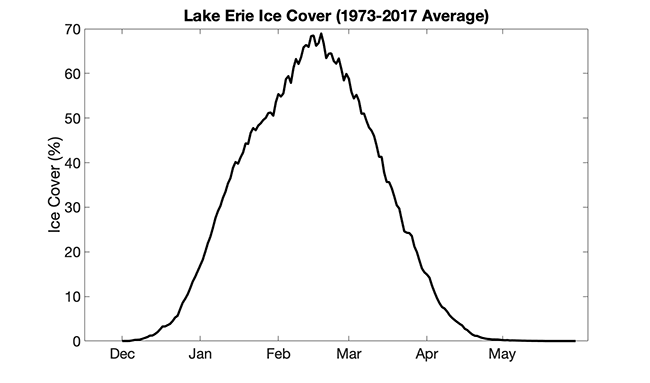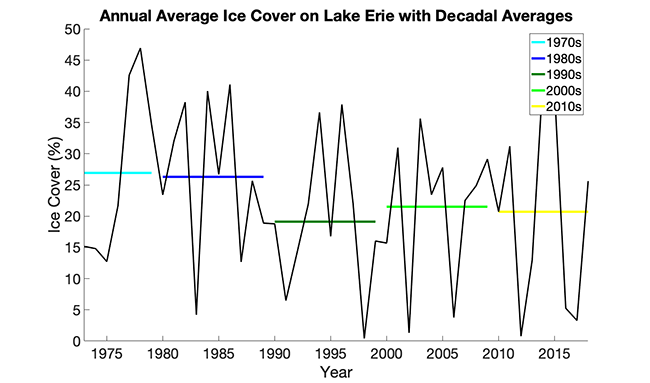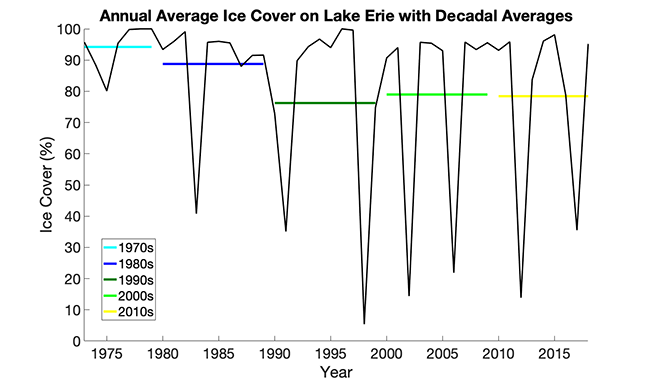Detroit River-Western Lake Erie Basin Indicator Project
Changes in Ice Cover in Lake Erie
Authors
Erin Maher, Great Lakes Integrated Sciences + Assessments, University of Michigan, eemaher@umich.eduKimberly Channell, Great Lakes Integrated Sciences + Assessments, University of Michigan, kimchann@umich.edu
Background
During the winter months, the Great Lakes, including Lake Erie, experience various amounts of ice coverage. In most years, Lake Erie freezes earlier than the other lakes and experiences the highest surface ice coverage, due to its comparatively shallow depth and warmer temperatures. The maximum ice concentration in Lake Erie, defined as the maximum amount of lake surface area that is covered with ice represented as a percentage, in Lake Erie often reaches 90% and above.
When considering annual maximum or average ice cover in the Great Lakes, it is common to treat each “ice year” as the period between December (of the previous year) and May (of the current year), as this is when freezing events occur in the region. Figure 1 demonstrates this, showing peak ice cover between February and March and zero ice cover in the beginning of December and after May. The analyses presented in the “Trends” section below use this time period (December to May) when discussing ice coverage in Lake Erie.

Figure 1. Average ice cover of Lake Erie from 1973 to 2017 presented as percentage of area covered by ice (ice concentration).
It is important to consider and monitor changes in ice cover in Lake Erie. Changes in percent ice coverage can lead to many different impacts including changes in evaporation rates, which have implications for lake levels and precipitation amounts. Ice cover also affects shipping and navigation, as well as seasonal recreational activities on the lakes.
In the following section, historical ice cover on Lake Erie is visualized using data from the Great Lakes Environmental Research Laboratory (GLERL), which compiles the data from the Canadian Ice Service and U.S. National Ice Center (Assel et al., 2002; 2005; 2013; Wang et al., 2012(1); 2018(1); 2018(2)). The use of data sourced from GLERL allows for high confidence in the analyses of this data.
Status and Trends
While there is annual variability in Lake Erie ice coverage, there has been, on average, less ice cover in the decades since the 1990s than in the decades prior to the 1990s. This trend is observed in both average and maximum annual ice coverage on the lake. Figures 2 and 3 demonstrate this trend, with Figure 2 showing decadal averages for annual average ice cover and Figure 3 showing decadal averages for annual maximum ice coverage.

Figure 2. Annual average ice cover on Lake Erie (black) with decadal averages (1970s (cyan), 1980s (blue), 1990s (dark green), 2000s (green), 2010s (yellow)).

Figure 3. Annual maximum ice cover on Lake Erie (black) with decadal averages (1970s (cyan), 1980s (blue), 1990s (dark green), 2000s (green), 2010s (yellow)).
While a downward trend in ice coverage since the 1990s is observed, it is important to note that there is still substantial inter-annual variability in ice cover on Lake Erie (Mason et al., 2016). Because of this, both high and low ice years are still possible, despite the downward trend.
Figure 3 also displays specific years where the maximum ice cover on Lake Erie was much lower than usual. These low ice years have occurred more frequently since 1998 than in previous years, with the time period between events decreasing from about 7-8 years to 3-4 years. Events such as these can be related to modes of natural climate variability, including El Niño Southern Oscillations (ENSO), the Arctic Oscillation (AO), and/or the North Atlantic Oscillation (NAO) (Wang et al,. 2012(2); Bai et al., 2012). For example, 1998 was a particularly strong El Niño year that contributed to higher than average winter temperatures and subsequently low ice coverage for Lake Erie. Future changes in these global-scale phenomena could have impacts on ice cover in Lake Erie.
Management Next Steps and Future Research Needs
In the future, ice cover changes in the Lake Erie should continue to be monitored. This will allow for continued analysis of regional trends and planning for future impacts. Monitoring both annual average and maximum trends in ice coverage will allow for better understanding of regional changes, and more informed decision making and planning.
Ice coverage can have various impacts on Lake Erie and its surrounding areas. Changes in the amount of ice cover affect evaporation rates in Lake Erie, with higher ice cover leading to less or no evaporation, and subsequently higher lake levels (Mishra et al., 2016). Lower ice coverage results in increased lake effect precipitation and increased evaporation rates, which contribute to lower lake levels. Lower lake levels can present problems for shipping, as ships are forced to take on less cargo to account for decreased lake depth, causing economic losses (U.S. Department of Commerce et al., 2019; Sousounis and Bisanz, 2000). However, decreases in ice coverage can make navigation of the lake possible for cargo vessels longer into the winter season, whereas higher ice years can create navigational challenges (Millerd, 2011). Fluctuations in ice coverage has implications for the hydropower and fishing industries as well, as they depend upon access to the lakes (Lofgren et al., 2002; Yapa et al., 1984). All of these impacts are important considerations for the management of the Western Lake Erie climate division.
References
- Assel, R.A., D.C. Norton, and K.C. Cronk. 2002. A Great Lakes Ice Cover Digital Data Set For Winters 1973-2000. NOAA Technical Memorandum GLERL-121.
- Assel, R.A. 2005. Great Lakes Ice Cover Climatology Update: Winters 2003, 2004, and 2005. NOAA Technical Memorandum GLERL-135.
- Assel, R.A., J. Wang, A.H. Clites, and X. Bai. 2013. Analysis of Great Lakes Ice Cover Climatology: Winters 2006-2011. NOAA Technical Memorandum GLERL-157.
- Bai, X., J. Wang, C. Sellinger, A. Clites, and R. Assel. 2012. Interannual variability of Great Lakes ice cover and its relationship to NAO and ENSO. Journal of Geophysical Research. 117: C03002.
- Lofgren, B. M., F.H. Quinn, A.H. Clites, R.A. Assel, A.J. Eberhardt, and C.L. Luukkonen. 2002. Evaluation of potential impacts on Great Lakes water resources based on climate scenarios of two GCMs. Journal of Great Lakes Research. 28: 537-554.
- Mason, L.A., C.M. Riseng, A.D. Gronewold, E.S. Rutherford, J. Wang, A. Clites, S.D.P. Smith, and P.B. McIntyre. 2016. Fine-scale spatial variations in ice cover and surface temperature trends across the surface of the Laurentian Great Lakes. Climatic Change. 138: 71-83.
- Millerd, F. 2011. The potential impact of climate change on Great Lakes international shipping. Climatic Change.104:629–652
- Mishra, V., K.A. Cherkauer, and L.C. Bowling. 2011. Changing thermal dynamics of lakes in the Great Lakes region: Role of ice cover feedbacks. Global and Planetary Change. 75:155-172.
- Sousounis, P. and J. M. Bisanz. 2000. Preparing for a Changing Climate. The Potential Consequences of Climate Variability and Change: Great Lakes. University of Michigan, Atmospheric, Oceanic and Space Sciences Department.
- Wang, J., R.A. Assel,. S. Walterscheid,. A.H. Clites,. and X. Bai. 2012. Great Lakes Ice Climatology Update: Winter 2006 – 2011 Description of the Digital Ice Cover Dataset. NOAA Technical Memorandum GLERL-155.
- Wang, J., X. Bai, H. Hu, A. Clites, M. Colton, and B. Lofgren. 2012. Temporal and Spatial Variability of Great Lakes Ice Cover, 1973–2010. Journal of Climate. 25: 1319-1329.
- Wang, J., J. Kessler, F. Hang, H. Hu, A.H. Clites, and P. Chu. 2018. Great Lakes Ice Climatology Update of Winters 2012-2017: Seasonal Cycle, Interannual Variability, Decadal Variability, and Trend for the period 1973-2017. NOAA Technical Memorandum GLERL-170.
- Wang, J., J. Kessler, F. Hang, H. Hu, A.H. Clites, and P. Chu. 2018. Analysis of Great Lakes Ice Cover Climatology: Winters 2012-2017. NOAA Technical Memorandum GLERL-171.
- Yapa, P.D. and H.T. Shen. 1984. Effect of ice cover on hydropower production. Journal of Energy. 110: 231-234.